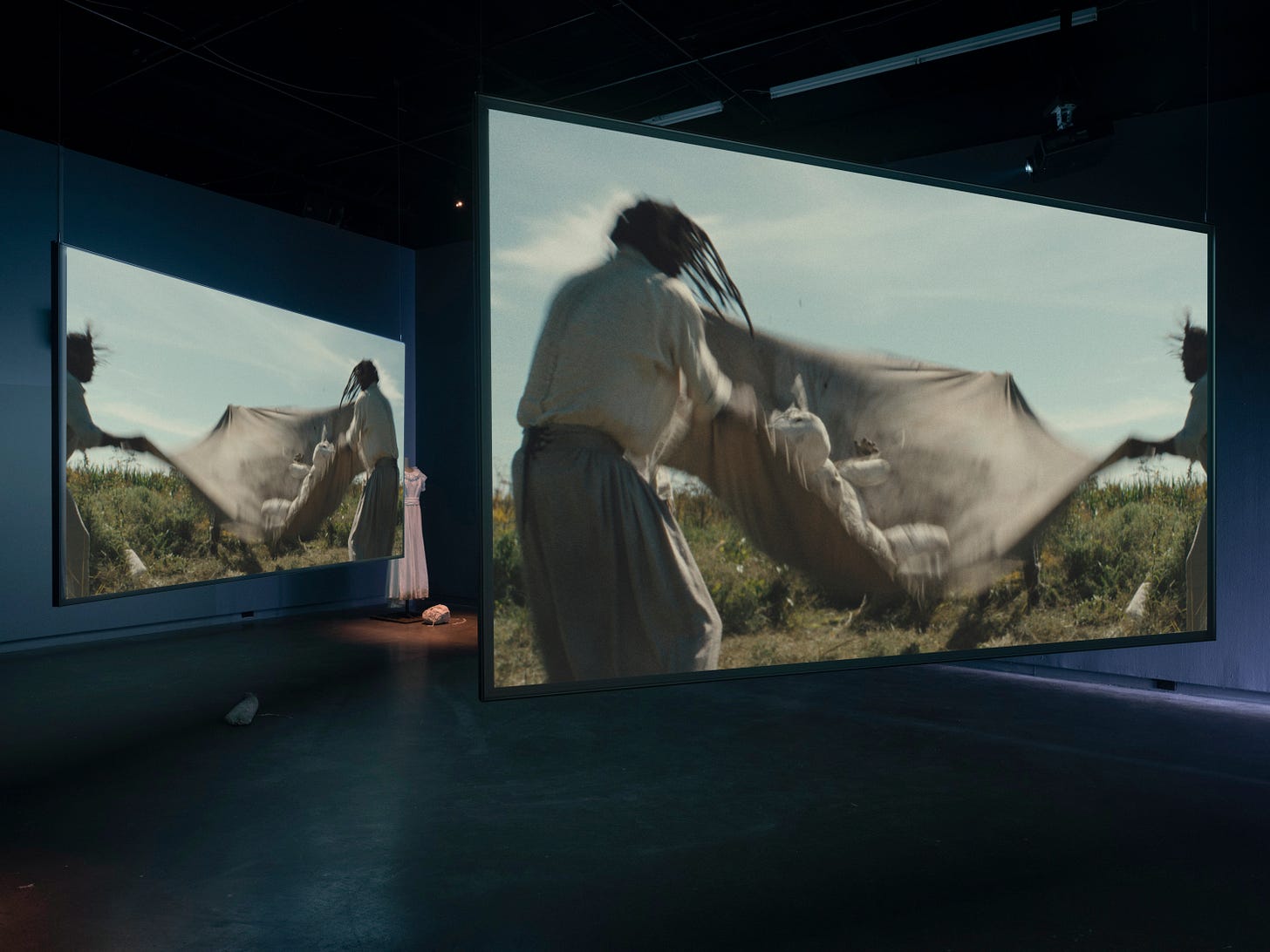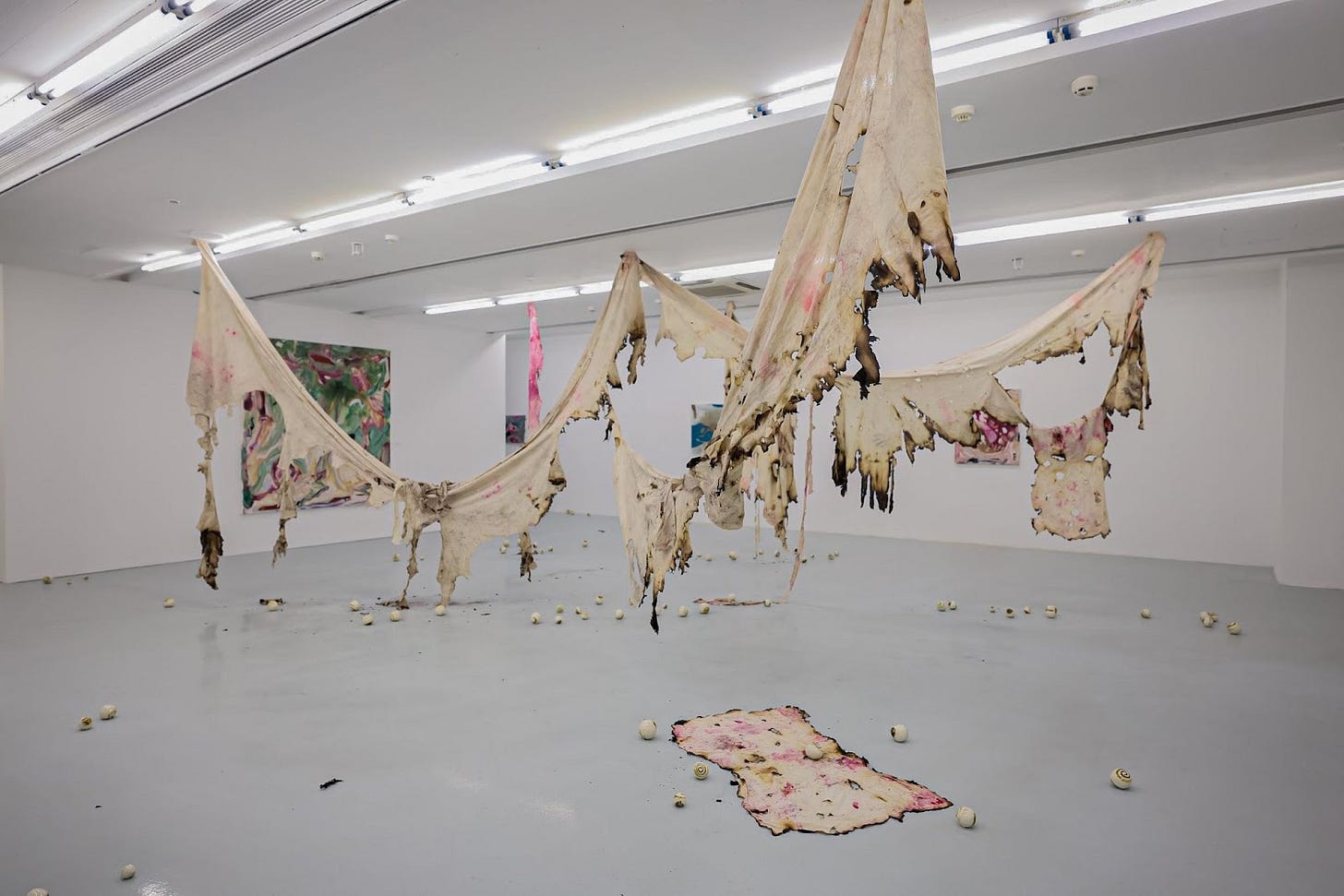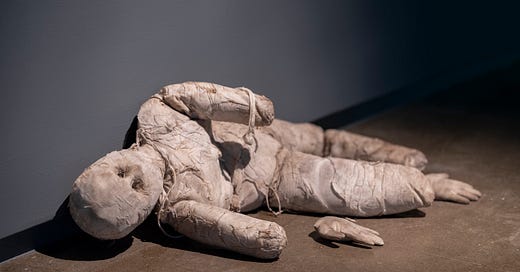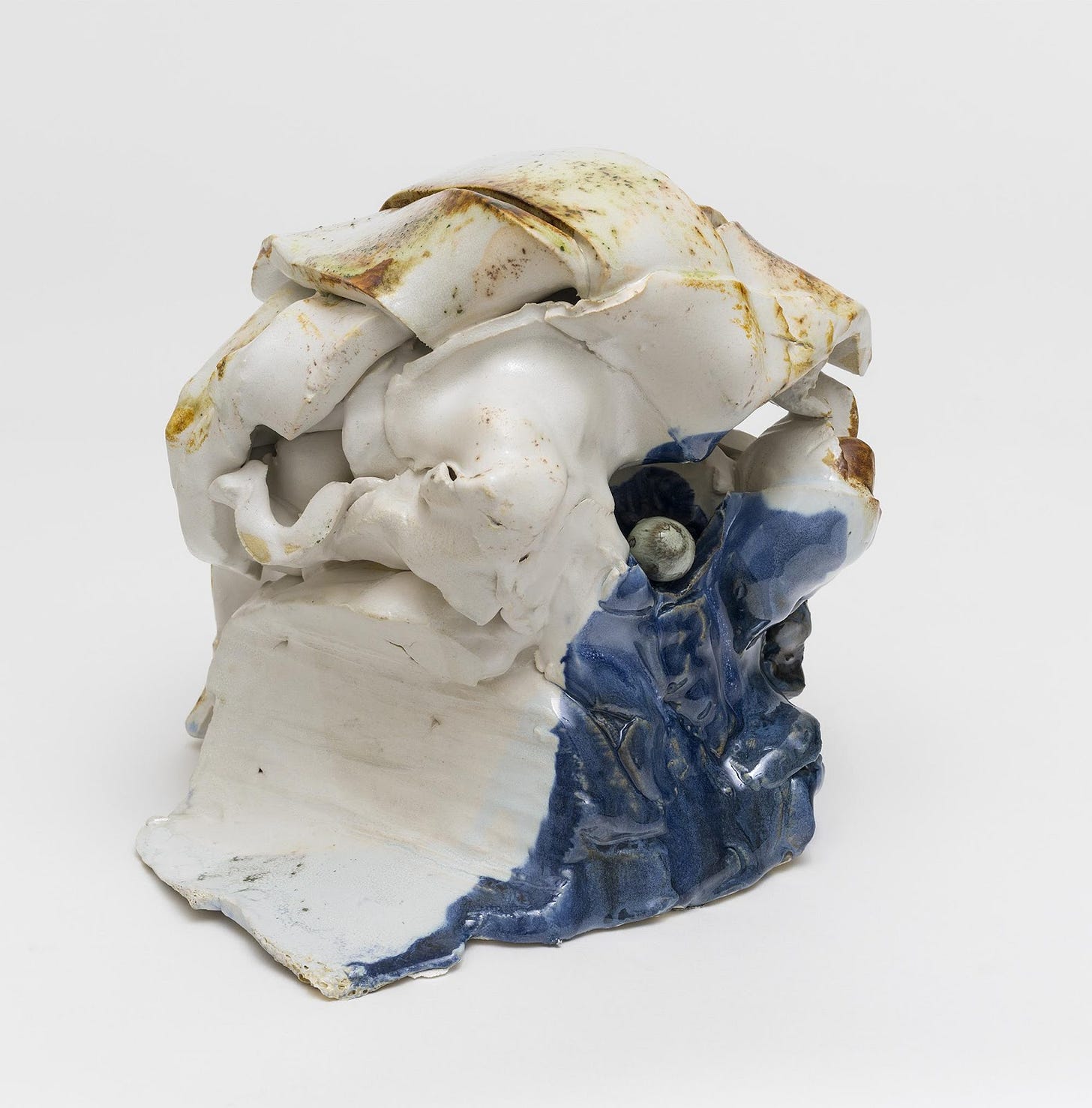Scrapbook's Artists & Aesthete series presents artist Manuel Mathieu
Here is art — a seemingly infinite string of adjectives in search of a song.
Instead of belaboring the state of the world this week, let me point to what is still here. Here is art — a seemingly infinite string of adjectives in search of a song. If natality, as Hannah Arendt once wrote, is the essential precondition of politics, art is where we begin, again.
So I will preface my interview with artist Manuel Mathieu, with his words and work, Pendulum (2024), which I recently saw at the Toronto Biennial of Art.
The two-screen film installation with sculptural elements is newly commissioned by the Toronto Biennial of Art. The film is Manuel’s first cinematographic installation.
Pendulum depicts the search for an equilibrium between the past and an uncertain future. A woman knowledge keeper carries on her shoulders her most precious legacy: the liberation of her soul. This legacy sets in motion a spiritual choreography in which a group of men master their own freedom. That freedom comes with the complexities of their humanity. It is through acts of faith and the passing on of our legacies that we preserve our humanity. That we connect with the source, the divine. The weaving of her soul comes apart under the cries rising up from their perpetual exorcism. Our history in turn endures beneath a shower of white comets . A new day begins.

You can view a trailer of the film here, and if you do have a chance to travel to Toronto, make time to see the entire Biennial, which runs till December 1.


I am deeply grateful to Manuel and to the other artists who have agreed to these interviews. This week, as in the many, many weeks to come, I will find succor in artists and their capacity to show us a different world in often cracked mirrors —an immense and difficult task, as it always has been. Thank you.
—Renuka Sawhney
What do you create, and what drives you to pursue this creative work?
My practice is grounded in spirituality, resilience and personal memories. I work with textures, colors, and layered compositions to reflect the tension between beauty and pain, but also the intricate nature of the human experience. My work is driven by a desire to articulate stories lingering in the corner of history while being deeply personal. The desire to bring these inner landscapes into shared spaces is what continues to drive my work.
How do you interpret the relationship between myth-making and identity in your art?
Myth-making and identity are deeply intertwined in my work. I see my practice as a space where fragments of identity that are conflicting and evolving, can coexist. Rather to define itself by a single narrative, my work aims to dismantle rigid identities to give room to more fluid expressions. By doing this, I hope that my work contributes to new understandings, not by erasing the past but by reframing it in a broader and more inclusive narrative.
In an era of global crises, I do not think art is confined to activism or reflection, but as an invitation. An invitation to confront, understand, and imagine a newer dialogue between the artwork and its spectator. A place for the viewer to be confronted and to process what is at stake. Each artwork is an opportunity to foster empathy and expand beyond limits that often rule the mainstream narrative.
In what ways do you believe art can serve as a counter-narrative to the dominant myths perpetuated by politics? How do you see your work engaging with or resisting these narratives?
Art is not like politics. It is not bound to a precise goal or consensus. Art acts as a space for ambiguity and dialogue. My work aim to resist an oversimplify narrative by addressing the reality of identity, postcolonialism, and community memory. Through abstract forms and composition, I try to recreate a visual language that challenges the dominant myths and invite the viewer to question what they are seeing.

For me, the personal is political. My work aims to be a place of authenticity, knowing that every step of its creation carries a certain weight. Integrity comes with embracing this creation process without allowing external forces to dictate the essence of the work.
Art itself can dissolve the idea of ‘‘otherness’’ by sharing an experience through contemplation. Observing the artwork becomes a place for empathy, and recognizing the familiar in the unfamiliar. Every viewer has its own references and understanding of the work they are seeing. By fostering this emotional bound, I think that art can challenge divisive ideologies and foster a sense of interconnectedness.
How do you use materials in your work?
Materiality is central to my work. Each material carries its own stories and significance. My work mostly has different layers and materials in them . I invite the viewer to observe each layer, each fragments, to challenge the surface level narrative that confronts them at first. This tension between material and the myth helps me question what is tangible and what is assumed at first.
Art is reflecting shared stories and emotion. I hope to capture collective experiences and thus create a sense of community especially through this polycrisis era that affected us all through various levels. In this case, art becomes a mirror of what the viewer is experiencing and carries the idea that individual identities can be intertwined with collective ones.
As an artist, how do you confront the fractures and ruptures in society—whether political, social, or environmental—through your work?
Ruptures in society are a key element to my work regarding the emotional baggage that they create in the individual affected by them. The ruptures often reveal what lies behind them and offer a chance to reconstruct and reimagine. In that sense, this allows the possibility of the emergence of new myths and identities which were shaped by those ruptures. Collective wounds shape societies, often leaving space for a deeper and stronger sense of individual identities.

Manuel Mathieu (b. 1986) is a multidisciplinary artist known for his vibrant and colorful paintings, which skillfully blend abstraction and figuration. His work explores themes of historical violence, erasure, and cultural approaches to physicality, nature, and spiritual heritage. Informed by his upbringing in Haiti, just after the fall of the Duvalier dictatorship, and his subsequent emigration to Canada at the age of 19, Mathieu's art delves into the shared links and struggles that unite us across national borders. He approaches political themes from a personal perspective, reflecting on solitude, death, survival, and desire.
He holds an MFA Degree from Goldsmiths, University of London, and has exhibited his work in various countries. He has had solo exhibitions at the Montreal Museum of Fine Arts, the Power Plant (Toronto), K11 Art Foundation (Shanghai) and the Longlati Foundation (Beijing). The Museum of Contemporary Art North Miami, De La Warr Pavilion (Bexhill-on-Sea, UK) and the Max Ernst Museum (Brühl) will present exhibitions by Mathieu in 2024 and 2025. Mathieu recently received the Best Short Film Award at the 2023 Festival International des Films sur l’Art.










